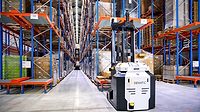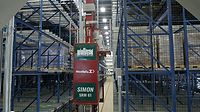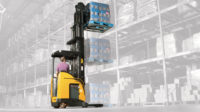Warehouse
Storage systems to combat labor shortage, promote facility ease
Storage automation helps beverage operations accommodate influx of SKUs

Image courtesy of Swisslog
In the 2009 romantic comedy “Confessions of a Shopaholic,” New York City journalist and shopping addict Rebecca Bloomwood starts working for a financial magazine after an email mix-up. Ironically, Rebecca writes in a column aimed to caution and educate everyday consumers about financial responsibility. Eventually, Rebecca’s ever-increasing debt and deception catch up to her, and she must make a change in order to save her career and reputation as a journalist.
Like Rebecca, warehouse storage operations have had to make changes — though it isn’t due to a shopping addiction. It’s because consumers now demand a greater selection and availability of products.
Mark Koffarnus, major accounts manager at Greenville, N.C.-based Yale Materials Handling Corp., notes that consumer demands and the growth of eCommerce have driven “unprecedented levels of SKU proliferation.” Because of this, operations must house and distribute larger assortments of inventory, he says.
“This is true across the warehousing sector, including in the beverage industry,” Koffarnus explains. “For beverage warehouse operations, this growth in product assortment means more frequent picking in order to fulfill these new order profiles, with rapidly changing picking and slotting methodologies making it difficult for many operations to keep up.”
Not only is there a change in pace for workflows, but distributors must also optimize their storage capacity, Koffarnus notes. The ability to utilize space and maximize capacity efficiently has become “even more essential” due to the rising cost of warehouse space, he adds.
Kyle Nevenhoven, principal consultant for Atlanta-based Dematic, says that many beverage warehouses weren’t designed to hold such diverse SKU profiles, which has created storage challenges.
“The biggest change in warehouse storage operations due to SKU proliferation is the change in storage types and practices from primarily block stacking inventory on the floor to extensive use of storage racking,” he explains. “Although pallet racks have been prevalent in the wine and spirits market for many years, it wasn’t until 10 to 15 years ago that you were likely to see very little to no rack in the other segments of beverage distribution, outside of the occasional drive-in rack.”
Inefficiencies are not only due to the lack of space, but also because it is difficult to access the SKUs. Nevenhoven says this is because of decreased storage density and a lack in vertical clearance for tall rack structures.
“Floor stacking, historically, has allowed storage to be very dense, but as SKU portfolios grow, floor stacking has proven difficult due to lack of SKU accessibility when attempting to achieve very dense storage,” he notes.
Innovations accommodating influx
With more SKUs emerging on the market, comes the need for producers and distributors to find new storage systems solutions, experts note.
Nevenhoven notes that many of the technologies being used by beverage distributors have been on the market for years, but not used as frequently outside of the wine and spirits sector — such as single-select rack, push-back rack, drive-in rack and pallet flow racks.
Some traditional storage systems have been “unable to fend off the impact of SKU proliferation,” he says, but advanced storage technologies have become more prevalent. These technologies include automated storage and retrieval systems (ASRS), pallet shuttle systems, automated guided vehicles (AGVs) and autonomous mobile robots (AMRs). Nevenhoven adds that pallet shuffle and AMR technologies are “newer to the market.”

Image courtesy of Dematic
Yale Materials’ Koffarnus says that increasing storage density and improving pick efficiency are two keys at adapting to the surge in SKUs.
“Certain equipment can enable more efficient slotting strategies, helping to increase SKU capacity and decrease picking travel times by expanding the ‘golden zone’ that operators can easily access and pick from,” he explains.
Koffarnus uses the example of a low-level order picker with a lifting and lowering operator platform, which would help increase accessible pick faces and slot capacity within the existing footprint of an operation.
“Operations have also gone vertical — converting otherwise unused space for storage by deploying reach trucks capable of servicing second- and third-level storage locations,” he says. “Double-deep reach capabilities enable equipment to reach into storage positions that are two pallet loads deep, helping warehouses further boost capacity to house growing SKU counts without compromising their ability to swiftly store and retrieve pallets and SKUs.”
Additionally, narrow aisles have become a popular way to up capacity thanks to lift trucks and other equipment designed to operate and succeed in such environments, Koffarnus notes. Certain equipment characteristics have advanced so that operators can work effectively and hit productivity targets in densely packed environments, he explains.
“Equipment designed with ergonomic advantages that provide a more flexible, comfortable work environment can also help maximize operator performance, allowing them to keep pace with the faster pick times and increased throughput required to meet consumer expectations for speedy delivery,” he says.
Beverage market impact on warehouses
Distributors and brand owners opting to consolidate their businesses impacts beverage warehousing. This can create challenges when it comes to storing product, even for the most ideal warehouse configurations, Dematic’s Nevenhoven says.
“Occasionally, those consolidation efforts bring a different type of pallet, height or weight profile into the mix of the distribution center, which may be incompatible with the existing storage infrastructure,” he explains. “Additionally, consolidation of facilities, and the effort to move distribution closer to the customer, creates difficulties in obtaining significant land within major urban areas, resulting in the need to grow vertically instead of horizontally.”
Yale’s Koffarnus adds that, when distributors and owners decide to expand product portfolios, it often comes through mergers and acquisition, which means that facilities designed to store and distribute one SKU must take on more than they were meant to handle.
“Clearly, capacity and storage density are impacted,” he says. “Beyond capacity constraints, operator and pedestrian safety are impacted, by moving more product in highly congested areas where aisles can be completely or partially blocked by too much product.”
Trends within the beverage industry also impact storage systems, experts note.
“With beverage warehouses stretched to piece together the necessary, it’s imperative that lift truck technology and other storage solutions are optimized to maximize the productivity of the labor that distributors do have on hand,” Koffarnus says “As operations work to maximize productivity at every turn, maintaining a strict focus on best lift truck operating practices can be a challenge.”
He stresses the importance of building and supporting safe, effective habits through training, because there is “so much riding on the performance of lift truck operators.” With beverage operations, Koffarnus notes that technology with alerts and assistance can help operators on the warehouse floor.
“While some may be familiar with systems that consider equipment status or load stability to provide a visual alert or even performance intervention in limited circumstances, a more advanced operator assist system (OAS), such as Yale Reliant, delivers real value by going several steps further,” he explains. “The solution beverages information related to the operating environment, including precise, real-time location and proximity data to enable automatic performance adjustments for a range of scenarios tailored to warehouse operations.”
Dematic’s Nevenhoven notes that operations have been impacted by urbanization, as operators scout out areas closer to the populations they serve.
“This is a major factor for storage systems in urban environments, because often it’s not possible or feasible to build large-footprint buildings, requiring the use of vertical space that isn’t always accessible with traditional storage methods,” he says. “Additionally, more demanding service level agreements, and compression of the delivery cycle, are creating a need to gain access to inventory faster and more freely further challenging traditional storage mechanisms.”
Going forward, Nevenhoven suspects that pallet shuttles are on the horizon for the beverage industry.
“The ability to get both very high rates from these systems, as well as take advantage of deep lane density, have allowed distributors and warehouse operators to store and receive significantly more inventory in a smaller footprint at rates that were unachievable with traditional automated storage systems,” he explains.
The four directional variant of pallet shuttles are well-equipped to handle diverse SKU portfolios, with the ability to “swarm and dig pallets out from deep lane storage locations,” he says. In high bay warehousing, Nevenhoven suggests rack supported, crane-based storage systems to be favorable.
Because of turnover rates in the industry, Koffarnus says that the best thing for businesses to do is prioritize training and reinforce the best practices of operating.
“Investments in technology, like operator assist systems and robotics, can help beverage operations get the most out of their labor and financial resources while keeping pace with increased demand,” he notes.
All about automation
As the workforce shortage continues to plague the industry, experts note that beverage distributors have had to find various solutions.
Yale’s Koffarnus notes that automation has been an important solution utilized by distributors.
“For example, robotic reach trucks are an automated solution for beverage distributors because they can help address the labor shortage and achieve greater storage density,” he says. “The high-lifting and double-deep capabilities of a robotic reach truck can help operations maximize existing space, while the capability to autonomously deposit and retrieve loads can help distributors address labor dependency, freeing them to reallocate available workers to more engaging, higher-value tasks that better support labor retention.”
Dematic’s Nevenhoven notes that the impact of automation on storage solutions has been both indirect and direct. Directly, the evolution of storage automation helps meet distributor profiles, building footprints and business goals differently than that of legacy technology, he says.
“In a more indirect manner, storage automation is impacted by the evolution of downstream automation processes, where a storage system may be more than an efficient inventory storage method, but may become the engine that replenishes, supplies or enables downstream processes that can be extremely impactful to an operation,” he explains.
Moreover, when automated systems are well maintained, they can lead to a “more repeatable and positive employee experience” because of enhanced operation consistency and predictability, he adds.
When considering the switch to an automated storage system, Nevenhoven notes that the biggest consideration is cost avoidance.
“Introducing storage automation may allow a distributor to absorb additional volume in their current facility without the need to add on to their current warehouse or reduce the footprint of the required action,” he explains. “Although there are clear labor savings associated with storage automation, often a form of cost avoidance is required to generate a positive return on investment.”
Another consideration is the reduction of inventory shrink and inventory obsolesce, which are positive factors of project payback, Nevenhoven notes.
Labor remains another big consideration regarding storage automation. More flexible systems using AGVs or AMRs “may show a stronger return on investment, as these technologies are direct labor replacements and require very little infrastructure or modifications to existing facilities to deploy and have a shorter implementation cycle,” Nevenhoven says.
Yale’s Koffarnus notes that labor challenges have changed automation from a long-term strategy to “a more immediate necessity” for operations. Robotic lift trucks reduce operating costs and improve productivity while also delivering a quick investment return — though he adds that this varies by operation.
“Several variables, such as the number of manual trucks replaced, robotic units purchased, operating hours and burdened labor rate will greatly influence the calculation of and speed of ROI,” Koffarnus says.
Looking for a reprint of this article?
From high-res PDFs to custom plaques, order your copy today!







